▼ Delhi Police gets bicycle patrol [05-31-17]
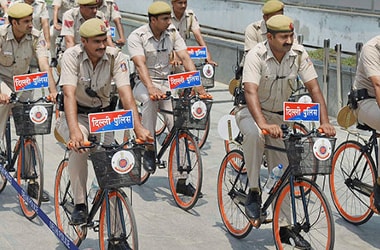 The Union Minister of State for Home Affairs flagged off the “Bicycle Patrols” launched by the Delhi Police. The first batch of 65 bicycles were allotted to the Eastern Range of Delhi Police. The Union Minister of State for Home Affairs flagged off the “Bicycle Patrols” launched by the Delhi Police. The first batch of 65 bicycles were allotted to the Eastern Range of Delhi Police.
As a ‘green' initiative for patrolling the parks, congested lanes and by-lanes, the cooperative societies etc, the Delhi Police has introduced bicycle patrols to complement and supplement its existing motorcycle and PCR patrols which focus mainly on crime prevention along the arterial and main roads of Delhi.
Cycle patrols can go where traditional patrol vehicles cannot. The bicycle patrols will reach the narrow and heavily congested areas where mechanized vehicles find it difficult to reach and maintain a steady presence.
They will also be utilized for patrolling during odd hours when the residents are taking rest, since they are less disturbing.
One of the main areas of focus of these bicycle patrols will be parks where citizens including senior citizens and women go for morning and evening walks.
The bicycle patrols will also be introduced in the University campus areas and near schools/colleges where the police officers can have a friendly interface with the student community.
With zero environmental costs and additional health benefits for the riders, the bicycle patrol parties will also bring the concept of ‘Policing by community involvement’ close to the largely immigrant and working class population which inhabits several areas of these three districts.
The credibility and legitimacy of policing largely depends on the community support that follows from transparency in police functioning, integrity in exercise of its functions/services, and the accountability in doing so.
The camaraderie developed by the bicycle patrol officers will further strengthen the strong community-oriented policing practised by Delhi Police.
The bicycle patrols will mostly be in ‘buddy pairs' and will normally cover a distance of 2 to 5 kilometres per patrol.
The patrolling officers are equipped with standard police communication equipment which will operate in ‘hands-free mode' and function like mobile police posts of the local Police Station.
Each bicycle has been fitted with cell phone docks and equipment for keeping other accessories.
While focusing on the ‘Policing by community involvement’ model, the bicycle patrols will, apart from assuring the law abiding citizenry of their friendly and protective presence, also play the role of area domination, sending out a message of deterrence to the law breakers in the vicinity.
Being slow paced, the spectrum of observation of bicycle patrol officers will be qualitatively much more meaningful in detecting unwarranted movements and questionable/suspicious presence in the areas of patrol.
The officers are being specifically trained to make a note of the happenings around them for sharing and validation.
As a beginning, a total of 65 high-end bicycles have been operationalised, - 30 for North East district, 20 for East district and 15 for Shahdara district.
|
▼ Dailong village accorded biodiversity status [05-30-17]
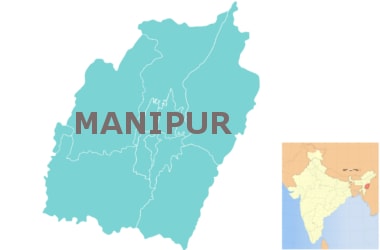 The Manipur government has declared Dailong village of Tamenglong district as a Biodiversity Heritage Site of the state. The Manipur government has declared Dailong village of Tamenglong district as a Biodiversity Heritage Site of the state.
A notification in this connection was issued by joint secretary of forest and environment, Kengoo Zuringla.
Dialong village, covering an area of 11.35 sq km, has been declared as Biodiversity Heritage Site under Section 37(1) of Biological Diversity Act, 2002.
The declaration was made after the recommendation of Manipur Biodiversity Board, the state government said in the notification.
Dailong: Know More
- Dailong is a medium size village located in Tamenglong of Tamenglong district, Manipur with total 234 families residing.
- The Dailong village has population of 1634 of which 819 are males while 815 are females as per Population Census 2011.
- Dailong village has lower literacy rate compared to Manipur.
- In 2011, literacy rate of Dailong village was 66.37 % compared to 76.94 % of Manipur. In Dailong Male literacy stands at 71.23 % while female literacy rate was 61.46 %.
- As per constitution of India and Panchyati Raaj Act, Dailong village is administrated by Sarpanch (Head of Village) who is elected representative of village.
|
▼ ART in Chitradurga: First ADE premier lab of DRDO [05-30-17]
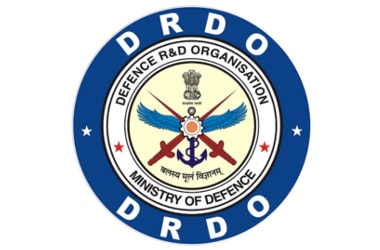 Aeronautical Test Range (ATR) is the first of its kind range that has been set up by the Aeronautical Development Establishment (ADE), one of the premier laboratories of the DRDO. Aeronautical Test Range (ATR) is the first of its kind range that has been set up by the Aeronautical Development Establishment (ADE), one of the premier laboratories of the DRDO.
ADE works on a range of UAVs (unmanned air vehicles). The facility will be an integrated test centre for a cluster of DRDO’s aeronautical laboratories.
The following labs will make use of the testing facility: the Centre for Air Borne Systems, the Gas Turbine Research Establishment, the Defence Avionics Research Establishment, the Centre for Military Airworthiness & Certification, all of which are based in Bengaluru, and finally the Aerial Delivery Research & Development Establishment, which is based in Agra.
The facility is meant to conduct flight-tests of indigenous unmanned and manned aircrafts such as naval and trainer versions of the Light Combat Aircraft, the unmanned air vehicles- Rustom-I and Rustom-II (Tapas); the Airborne Early Warning & Control Systems (AEW&C), Air-to-Ground weapons, parachutes and aerostats, etc.
Karnataka, especially Bengaluru, and its tech ecosystem not only leads India, but is a leader on the global horizon.
Technology companies and their facilities located in Bengaluru are helping us create new facilities in other places in the country.
DRDO indicated the ATR, sprawling 4,090 acres, was built at a cost of INR 290 crore.
The ATR campus has 31 buildings and a 2.2km runway that can be expanded to 3km to help larger aircraft land and take off.
It has two hangers to house UAVs, radar centre, fibre-optic network, and a separate residential complex on 200 acres.
|
▼ India - Largest milk producer in the world! [05-29-17]
 Government of India has undertaken several new initiatives in the field of animal husbandry in Gujarat. Government of India has undertaken several new initiatives in the field of animal husbandry in Gujarat.
Under Rashtriya Gokul Mission, on the lines of Gokul Gram ‘Gir, Cow Sanctuary’ has been approved. This will be established in Dharampur, Porbandar under Livestock insurance coverage.
This scheme has been implemented in all the districts of the state, whereas earlier only 15 districts were included.
During the year 2014-16, about 26,000 animals have been insured in the state.
To fulfil the shortage of veterinarians, a veterinary college has been established in Junagadh.
The Agriculture Minister announced our country is number one in milk production in the world.
In the year 2015-16, the growth rate of milk production has been 6.28 per cent due to which total production has reached 156 million tonnes.
And now, per person milk availability is 337 gram on an average, while on the world level it is 229 gram. It is worth mentioning that in comparison to the years 2011-14, the growth in milk production during the years 2014-17 has been 16.9 per cent.
The standard of living of urban and rural families is rising, therefore, the demand for the animal protein is increasing.
So, it is necessary that we constantly make effort to increase the production of our livestock, poultry and fish so that the country's citizens are well-nourished and healthy. That is why it is the responsibility of veterinarians to contribute in keeping the nation healthy by increasing availability of animal protein.
The Government is committed to double farmers' income by 2022 and veterinaries play a significant role in fulfilling the Government’s resolution to double the farmers’ income. A healthy animal will result in greater production which will automatically enhance the farmer’s income and the country will proceed on the path of economic prosperity.
India's Livestock Market: Know More
- Agriculture Minister said that India is world’s highest livestock owner at about 512.05 million out of which 199.1 million are bovines, 105.3 million buffaloes, 71.6 million sheep and 140.5 million goats.
- In the case of goats, India is at the second position in the world and it is approximately 25 % of the livestock.
- India is second largest poultry market in the world and it includes the production of 63 billion eggs and 649 million poultry meat.
- India's marine and fish industry are growing at around 7 percent compound annual growth rate. Overall, India’s livestock sector is growing fast and emerging as a major contributor in the global market.
|
▼ First e-vehicle fleet in India launched in Nagpur [05-29-17]
 Marking the third anniversary of the Narendra Modi government, Union surface transport minister Nitin Gadkari along with chief minister Devendra Fadnavis flagged off taxi aggregator Ola’s e-vehicle (EV) services in the city. Marking the third anniversary of the Narendra Modi government, Union surface transport minister Nitin Gadkari along with chief minister Devendra Fadnavis flagged off taxi aggregator Ola’s e-vehicle (EV) services in the city.
It will be the first in country to have such a service.
A battery charging station for the vehicles was also inaugurated at the airport where the launch function was held.
State government will come up with measures to promote setting up of charging stations.
This is expected to be a major job provider especially to the technically educated youth.
To begin with, Ola will be having four charging centres in the city.
Its services will include taxis, auto-rickshaws and a couple of buses. Car-maker Mahindra and Mahindra is the major ally of Ola and is supplying 200 taxis.
The company also launched its e-autorickshaws on the occasion. Kinetic Green has provided 100 e-rickshaws to Ola.
This is India’s first multi-modal electric vehicle project at the Nagpur Airport Complex.
The pilot project will have a fleet of 200 electric vehicles including taxis, buses, e-rickshaw and autorickshaws.
All these electric-powered public transport vehicles will be fully owned by cab aggregator Ola. For the project Mahindra & Mahindra has manufactured 100 e2o electric taxis.
Similarly, vehicles have been sourced from other manufacturers like Tata Motors, Kinetic, BYD and TVS, among others.
In addition, four electric charging station has also been built by Ola in various places of Nagpur including the Nagpur airport.
Shared and electric vehicles: Know More
- As per the NITI Aayog’s recent joint report with Rock Mountain Institute, adoption of electric and shared vehicles could help the country to save $60 billion in fuels while cutting down as much as 1 gigatonne (GT) of carbon emission by 2030
- According to Mahindra & Mahindra, it has made a total investment to the tune of Rs600 crore in technology, products, and plants of e-vehicles.
- The company already has manufactured 2,700 e-vehicles which are running across India which are clocking around 14 million kms per day.
- Ola has stated that it has invested Rs50 crore in the Nagpur initiative and has plans to further scale up its operations by investing $2 billion in e-vehicles across all cities of India.
- It has set an ambitious target of running one million electricity-powered vehicles on the Ola platform by 2020.
|
▼ Sale of cattle for slaughter banned [05-29-17]
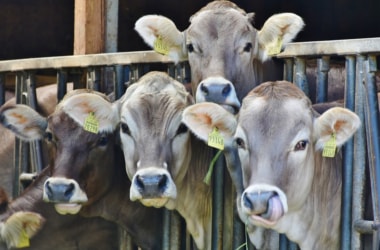 The Union Ministry of Environment and Forests on 23 May 2017 came up with new regulations that ban the sale of all kinds of cattle for slaughter across India. The rules were issued under the Prevention of Cruelty to Animals Act, 1960. The Union Ministry of Environment and Forests on 23 May 2017 came up with new regulations that ban the sale of all kinds of cattle for slaughter across India. The rules were issued under the Prevention of Cruelty to Animals Act, 1960.
It requires anyone purchasing cattle to provide an undertaking that the animals are bought for agricultural purposes and not slaughter.
The definition of cattle includes bulls, bullocks, cows, buffalos, steers, heifers, calves and camels.
The new rules will be implemented in the next three months.
The cattle trade is permitted only among farm land owners across the nation.
Cattle can only be sold to a person possessing documents that he/she is an agriculturist.
A trader has to submit five copies of proof of sale at the local revenue office, the local veterinary doctor in the district of the purchaser, animal market committee, apart from one each for seller and buyer.
The new regulations state that cattle bought cannot be resold within six months. It also states that young and unfit animals cannot be traded.
Animal markets cannot be set up within 50 kilometres of an international border and 25 kilometres of a state border. Transporting cattle outside of India will require special approval of the state government nominee.
All animal markets will have to seek the approval of district animal market committee to be headed by a magistrate. The committee will also have two representatives from government-approved animal welfare groups.
Norms for Cattle Regulation: Know More
- The new regulations state around 30 norms for animal welfare in markets, like water, fans, bedding, ramps, non-slippery flooring, veterinary facility and separate enclosure for sick animals among others. The owner of the animal has to bear the cost of its upkeep in a shelter.
- In case, the owner is unable to pay, the cost would be recovered as land arrears.
- The state government will specify the costs every year on 1 April.
- The new rules do not amount to a wide ban on cattle slaughter or its trade.
- However, they will constrict supplies to India’s meat industry which meets 90 per cent of its requirement from animal markets.
|
▼ Meet Robocop, the world's first operational robot police officer [05-26-17]
 The Dubai police on 22 May 2017 officially inducted the world’s first operational robot police officer Robocop into the force at the 4th Gulf Information Security Expo and Conference (GISEC). The Dubai police on 22 May 2017 officially inducted the world’s first operational robot police officer Robocop into the force at the 4th Gulf Information Security Expo and Conference (GISEC).
The launch of the world’s first operational Robocop is a significant milestone for the United Arab Emirates’ vision to be a global leader in smart cities technology adoption.
The Robocop is over 5 feet tall and weighs 100 kg. It has a facial recognition software with which it can identify offenders.
The robot is capable of speaking six languages and people can use its built-in tablet device to access various police services.
Through its tablet, it can also communicate with people, respond to public queries, shake hands and can do a military salute.
It features an emotion detector through which it can recognize a person’s gestures and body language from nearly five feet away.
It can identify hand gestures from a distance of up to 1.5 metres. The Robocop can tell when you are happy, sad or even smiling and will itself respond accordingly.
More importantly, when it comes to fighting crime, the robot uses the internet of things, artificial intelligence and other smart technologies to spot offenders.
It can live stream video footage to police officers in the force’s command and control centre via an inbuilt camera. Its navigation skills enable it to map out areas and travel on its own.
Its in-built integrated system will have it connected to social media and other applications. It doesn’t need a visa, medical insurance or hours of training.
|
▼ Dhola-Sadia - Ready to use, longest river bridge in Assam! [05-26-17]
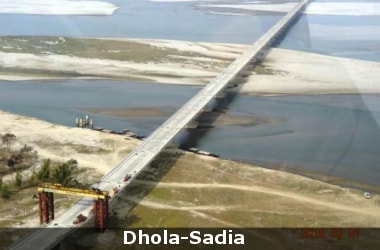 Prime Minister Narendra Modi will inaugurate India’s longest, ready to use river bridge - the Dhola-Sadia Bridge in Assam. Prime Minister Narendra Modi will inaugurate India’s longest, ready to use river bridge - the Dhola-Sadia Bridge in Assam.
In 2016, ADB signed a USD 500 million loan with GoI to build a 9.8 km long road bridge across River Ganga, which will become the longest river bridge in the country upon construction. This bridge will improve connectivity between north and south Bihar.
The construction of Dhola Sadiya bridge began in 2011. The cost of the project is about INR 2056 crores.
Dhola-Sadia Bridge is a three lane bridge stretching 9.15 kilometre built over river Lohit, which is a tributary of the Brahmaputra river. the bride was built by Navayuga Engineering Co. Ltd.
The bridge will connect Sadia, which is 540 Km from Guwahati and Dhola, 300 Km from Itanagar.
Bandra Worli Sea Link
The Dhola-Sadiya bridge is 3.55 km longer than the Bandra–Worli Sea Link in Mumbai which is the third largest bridge in the country.
Ganga Bridge
In 2016, ADB signed a USD 500 million loan with GoI to build a 9.8 km long road bridge across River Ganga. This will improve transport connectivity between northern and southern parts of Bihar besides linking the capital city of the state. This is currently India's longest river bridge, announced.
| Ganga River Bridge | 9.8 km | | Dhola-Sadia River Bridge | 9.15km | | Bandra Worli Sealink | 5.6 km |
Dhola-Sadia Bridge: Know More- The bridge has been designed to withstand the weight of 60-tonne battle tanks.
- This will be the only bridge in the region that will be strong enough to withstand the travel of tanks to Tinsukia, a place from where Indian troops usually enter Arunachal.
- Road connectivity between Dhola to Sadia will boost overall economic development of the areas north of Brahmaputra in upper Assam and Arunachal Pradesh.
- The bridge fills a huge connectivity gap that existed in the north east region. Till now, the only means to cross this location was a ferry travel which was not possible during floods.
- The construction of the bridge will reduce the distance from Rupai on NH- 37 in Assam to Meka-Roing on NH-52 in Arunachal Pradesh by 165 Km.
- This reduction in travel time is expected to result in saving of petrol and diesel worth 10 lakh rupees per day.
|
▼ World's oldest human ancestor! [05-26-17]
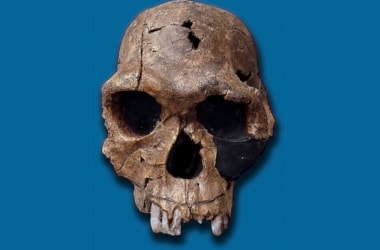 A new study claims that the split of the common lineage of great apes and humans probably occurred in Europe and not in Africa. A new study claims that the split of the common lineage of great apes and humans probably occurred in Europe and not in Africa.
The bold hypothesis is based on an analysis of 7.2-million-year-old fossil remains.
As of now, it was widely believed that the human lineage split from that of apes some 7 million years ago in Africa.
According to the new study, the common lineage of great apes and humans split several hundred thousand years earlier than assumed until now.
The research team analysed the two known specimens of the fossil hominid Graecopithecus freybergi: a mandible (lower jaw) from Greece and an upper premolar tooth from Bulgaria.
Using computer tomography, the researchers visualised the internal structures of the fossils and demonstrated that the roots of premolars are widely fused.
Great apes typically have two or three separate and diverging roots, whereas the roots of Graecopithecus converge and are partially fused, which is a feature that is characteristic of modern humans, early humans and several pre-humans including Ardipithecus and Australopithecus.
The lower jaw, nicknamed ‘El Graeco’ by the scientists, has additional dental root features, suggesting that the species Graecopithecus freybergi might belong to the pre-human lineage.
Furthermore, Graecopithecus is several hundred thousand years older than the oldest potential pre-human from Africa, the six to seven million year old Sahelanthropus from Chad.
The research team dated the sedimentary sequence of the Graecopithecus fossil sites in Greece and Bulgaria with physical methods and got a nearly synchronous age for both fossils: 7.24 and 7.175 million years old.
Recent analysis of a 3.3-million-year-old hominin fossil has provided researchers with the most complete human spine of any early human relative.
The analysis offers a unique snapshot of a crucial transition point as humans’ early ancestors evolved towards bipedalism.
The findings were published in the journal Proceedings of the National Academy of Sciences.
The fossil, known as Selam, is a nearly complete skeleton of a two-and-half-year-old child discovered in Dikika, Ethiopia, in 2000.
Selam: Know More
- Selam was an early human relative from the species Australopithecus afarensis. Selam means peace in the Ethiopian Amharic language.
- The research shows that the general structure of the human spine emerged over 3.3 million years ago. The fossil provided the first glimpse into how humans’ early ancestors’ spines were organised.
- At the European Synchrotron Radiation Facility in Grenoble, France, the research team used high-resolution imaging technology to visualise the bones of Selam.
- The scans indicated that Selam had the distinctive thoracic-to-lumbar joint transition found in other fossil human relatives.
- The specimen is the first to show that, like modern humans, our earliest ancestors had only twelve thoracic vertebrae and twelve pairs of ribs. That is fewer than in most apes.
- This unusual early human configuration may be a key in developing more accurate scenarios concerning the evolution of bipedality and modern human body shape.
- This configuration marks a transition toward the type of spinal column that allows humans to be the efficient, athletic walkers and runners.
|
▼ US and 6 Gulf Countries sign counter-terrorism MoU [05-25-17]
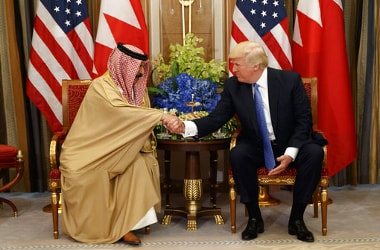 The United States and six Gulf countries on 23 May 2017 signed a Memorandum of Understanding (MoU) to curb financing terror organisations like Islamic State, Al-Qaeda, Hizbollah, Lashkar-e-Taiba, Taliban and the Haqqani Network. The United States and six Gulf countries on 23 May 2017 signed a Memorandum of Understanding (MoU) to curb financing terror organisations like Islamic State, Al-Qaeda, Hizbollah, Lashkar-e-Taiba, Taliban and the Haqqani Network.
The MoU was signed by the US and six members of the Gulf Cooperation Council (GCC) in Riyadh.
These six Gulf Countries are Bahrain, Kuwait, Oman, Qatar, Saudi Arabia and the United Arab Emirates.
The MoU was signed during US President Donald Trump’s historic visit to Saudi Arabia.
Under the MoU, all seven countries together aim to establish Terrorist Financing Targeting Center (TFTC).
The Terrorist Financing Targeting Centre will enhance existing tools and cooperation with partners in the Gulf to forcefully address evolving threats.
This collaboration will also address a host of other transnational threats originating throughout the Middle East, including from Iran, the Assad regime and the situation in Yemen.
These seven countries intend to identify, track and share information regarding terrorist financial networks and related activity of mutual concern.
The MoU is seen as a vital step against terrorist activities as it is believed that Gulf countries are a major source of funding major terrorist organisations across the globe including Lashkar-e-Taiba, which is responsible for major terror attacks in India.
Middle East Demographics: Know More
- The Middle East is a transcontinental region centred on Western Asia and Egypt.
The corresponding adjective is Middle-Eastern and the derived noun is Middle-Easterner. - The term has come into wider usage as a replacement of the term Near East (as opposed to the Far East) beginning in the early 20th century.
- Arabs, Turks, Persians, Kurds, and Azeris (excluding Republic of Azerbaijan) constitute the largest ethnic groups in the region by population.
- Indigenous minorities of the Middle East include Jews, Assyrians and other Arameans, Baloch, Berbers, Copts, Druze, Lurs, Mandaeans, Samaritans, Shabaks, Tats, and Zazas. In the Middle East, there is also a Romani community.
- European ethnic groups that form a diaspora in the region include Albanians, Bosniaks, Circassians, Crimean Tatars, Franco-Levantines, and Italo-Levantines.
|
▼ Swachh Bharat App launched for ASI monuments [05-25-17]
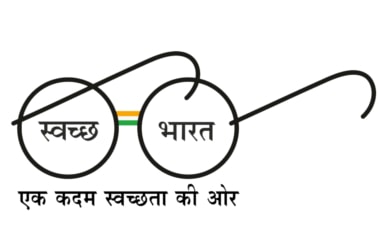 Culture Minister Mahesh Sharma has launched Swachh Bharat app at the National Museum in New Delhi. Culture Minister Mahesh Sharma has launched Swachh Bharat app at the National Museum in New Delhi.
The app will enable visitors to report garbage on the premises of the ASI monuments across the country.
Around 30 galleries in the National Museum have already been equipped with a device that will make use of the intranet to connect to the app.
The services of the app will be soon rolled out in 116 monuments under the Archaeological Survey of India (ASI) across the country.
The devices installed in the monuments will connect to this app using Bluetooth.
The devices will have a range of around 30 metres.
The visitors with the help of the app would be permitted to report the culture ministry any litter or garbage on the premises of the monuments.
The app is available for Android mobile phones. As soon as the visitors enter the premises of the monuments and switch on the Bluetooth, the app will relay Swachh Bharat-related information to the visitors and will ask them to report any garbage around them.
Even if the visitors have not installed the App on their handsets, a message will be delivered by Google about the Swachh Bharat Abiyan and will provide the visitors with a link to install the App.
The Swachh Bharat App will be monitored by the Ministry of Culture. The App is expected to promote cleanliness in the premises of ASI monuments.
|
▼ India's first underwater tunnel under River Hooghly [05-25-17]
 The two organizations Afcons Transtonnelstroy and Kolkata Metro Railway Corporation Ltd (KMCRL) involved in implementing the East West Metro have completed boring the India’s first underwater tunnel under the Hooghly river to link Howrah and Kolkata. The two organizations Afcons Transtonnelstroy and Kolkata Metro Railway Corporation Ltd (KMCRL) involved in implementing the East West Metro have completed boring the India’s first underwater tunnel under the Hooghly river to link Howrah and Kolkata.
The length of Kolkata’s East West Metro is 16.6 km long.
Out of which a length of 502 metres is under the Hooghly river. The project is built by Afcons Transtonnelstroy and implemented by KMRCL.
Afcons Transtonnelstroy is an Indo-Russian joint venture. The project connects Howrah to the west and Salt lake to the east.
Digging the underwater tunnel was the critical task in the project.
A massive tunnel boring machine called Rachna was used for boring the underwater tunnel. The tunnel boring job was completed within in a time of one month and six days well ahead of schedule.
The East West Metro with a length of 16.6 km will have 12 stations, six of which will be underground stations. The project which was slated to be completed by 2012 got postponed many times. The final commissioning of the project is expected to be held by December 2019.
|
▼ IIT Kharagpur, MP sign Happiness Index MoU [05-24-17]
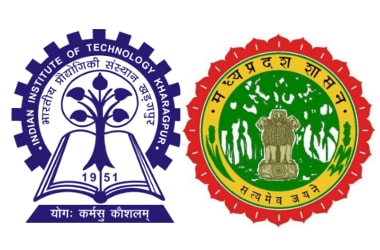 IIT Kharagpur’s Rekhi Centre of Excellence for the Science of Happiness and Madhya Pradesh government’s ‘Rajya Anandam Sansthan’ (Department of Happiness) has signed an MoU. IIT Kharagpur’s Rekhi Centre of Excellence for the Science of Happiness and Madhya Pradesh government’s ‘Rajya Anandam Sansthan’ (Department of Happiness) has signed an MoU.
They will collaborate on the development of a Happiness Index for measuring the well-being of the residents of the state.
The Happiness index would be developed by IIT-KGP and the data collected by the state government would be analysed to assess the happiness levels of people of the state and to suggest recommendations to enhance happiness levels in the state.
IIT-Kharagpur will also develop an online screening and assessment system to suitably identify the volunteers from more than 30,000 people who have expressed their desire to be part of the collaborative effort.
Additionally, IIT-KGP will also develop online courses on happiness with the help of evaluation system available at its Center for Educational Technology.
India has been ranked at 122 out of 155 countries in the 2017 United Nations’s World Happiness Index (WHI).
Among the 8 SAARC nations, Pakistan is at 80th position, Nepal stood at 99, Bhutan at 97, Bangladesh at 110 and Sri Lanka is at 120.
The list is topped by Norway, followed by Denmark, Iceland, Switzerland and Finland.
The rankings are based factors such as inequality, life expectancy, GDP per capita, public trust (i.e. a lack of corruption in government and business), and social support.
Together they are used to generate a happiness score of country on a scale from 1 to 10.This year is the fifth such report since the first was published in 2012.
IIT-KGP, which is recognized as an Institute of National Importance was established in 1951 by the Government of India. It was the first IIT to be established in the country.
|
▼ 13 year old wins first Asia Level Yoga Competition [05-24-17]
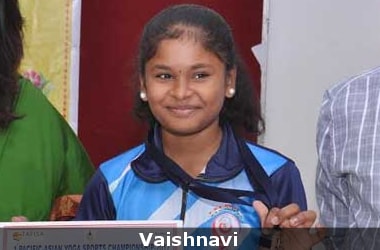 Thirteen-year-old Vaishnavi of India beat hundreds of competitors to win the first Asia Level Yoga Competition. Thirteen-year-old Vaishnavi of India beat hundreds of competitors to win the first Asia Level Yoga Competition.
The competition, featuring teams from five nations, was held in Thailand on May 13 and 14.
June 21 is International Day of Yoga. The U.N. designated the day on the urging of Indian Prime Minister Narendra Modi.
More than 150 students from countries like India, Singapore, Malaysia and Thailand participated in first ‘Pacific-Asia Level Yoga Competition’ held in Bangkok, Thailand on May 13 and 14.
From India, 15 students performed in the junior category (13-15 years).
In that competition Vaishnavi secured first place and the overall championship. She has staged more than 1,000 performances and has totally received more than 200 gold medals.
She has won more than 60 gold medals in district-level yoga competitions and overall championship in the national-level competitions held in Cochin, Gujarat and Bengaluru.
She has secured the overall championship in national-level yoga competition held in Andaman, Indonesia, Sri Lanka and Thailand.
|
▼ International Day for Biological Diversity: 22nd May 2017 [05-23-17]
 The International Day for Biological Diversity was celebrated globally on 22 May 2017 with the theme “Biodiversity and Sustainable Tourism”. The International Day for Biological Diversity was celebrated globally on 22 May 2017 with the theme “Biodiversity and Sustainable Tourism”.
The theme was chosen as it coincides with the observance of 2017, which is the International Year of Sustainable Tourism for Development, and also to contribute to ongoing initiatives like the Sustainable Tourism Programme.
The observance of the day aims to raise awareness of the important contribution of sustainable tourism to economic growth as well as to the conservation of biodiversity.
While the diversity in species, ecosystems and landscapes plays a huge role in attracting tourism and promoting economic growth, a well-structured tourism sector can help reduce threats to wildlife population and in turn maintain and increase the biodiversity through the revenue obtained from tourism.
Though there is a growing recognition that biological diversity is a global asset of tremendous value to present and future generations, the threat to species and ecosystems continues at an alarming rate due to certain human activities.
The United Nations Environment Programme (UNEP) convened the Ad Hoc Working Group of Experts on Biological Diversity in November 1988 to explore the need for an international convention on biological diversity.
In May 1989, the Adhoc Working Group of Technical and Legal Experts was established to prepare an international legal instrument for the conservation and sustainable use of biological diversity.
The group’s work culminated on 22 May 1992 with the Nairobi Conference for the Adoption of the Agreed Text of the Convention on Biological Diversity.
The Convention entered into force on 29 December 1993. It represents a dramatic step forward in the conservation of biological diversity, sustainable use of its components and the fair and equitable sharing of benefits arising from the use of genetic resources.
Given the importance of public education and awareness for the implementation of the Convention, the General Assembly proclaimed 22 May, the date of the adoption of its text, as the International Day for Biological Diversity.
UNEP: Know More
- Headquarters: Nairobi, Kenya
- Head: Erik Solheim
- Formation: 5 June 1972
- Founded: 1972
- Director: Erik Solheim
- Founders: Wangari Maathai, Maurice Strong
- Parent organization: United Nations
|
▼ India commissions CRMM study [05-22-17]
 India along with countries like Argentina, Burkina-Faso, Chad, France, Ivory Coast, Mali, Namibia, Niger, Nigeria, Senegal, Uganda and Yemen has jointly commissioned a study to define and structure a Common Risk Mitigation Mechanism (CRMM). India along with countries like Argentina, Burkina-Faso, Chad, France, Ivory Coast, Mali, Namibia, Niger, Nigeria, Senegal, Uganda and Yemen has jointly commissioned a study to define and structure a Common Risk Mitigation Mechanism (CRMM).
This is in the context of solar power generation projects in solar rich countries.
The commissioning of the study is aimed at dramatic reduction in the cost of finance for renewable energy and the overall price of electricity.
The exercise is part of the international efforts aimed at implementing the Paris Declaration of the International Solar Alliance (ISA) adopted on 30 November 2015.
The study has been entrusted to a task force chaired by Terrawatt Initiative (TWI), the World Bank Group, the Currency Exchange Fund (TCX), the Council on Energy, Environment and Water (CEEW) and also the Confederation of Indian Industries (CII).
Each of the participating countries will also appoint a qualified representative who will cooperate with the task force and provide information regarding the country specific expectations, experience and needs of the task force.
All the countries lying fully or partially between the Tropics are also invited to join the task force and support this initiative in order to attract investments into solar sector.
The Council on Energy, Environment and Water calculates the cost of capital to form a substantial amount in the total costs of renewable energy.
In India it accounts for 70% of the total cost of solar Power. In this regard, the CRMM is expected to offer a simple and affordable tool that will develop a secure environment for private institutional investment in solar assets. ISA
On the first day of the COP-21 summit, the International Solar Alliance was launched by Indian Prime Minister Narendra Modi and French President Francois Hollande as a union of countries with abundant sunlight.
ISA: Know More
- Under this alliance, 121 countries that fall within the tropics {i.e. between Tropic of Cancer and Tropic of Capricorn} have been invited to make collaborative efforts to harness solar energy to generate the electricity.
- Most of these countries fall within Asia, Africa and South America.
- There are three objectives behind the International Solar Alliance.
- First is to force down prices by driving demand;
- Second is to bring standardization in solar technologies
- Third is to foster research and development.
|
▼ UNICEF announces rise in child migrants and refugees [05-22-17]
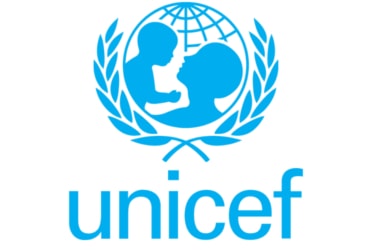 The United Nations Children’s Fund (UNICEF) on 18 May 2017 announced that the number of children travelling alone has increased five times since 2010. The United Nations Children’s Fund (UNICEF) on 18 May 2017 announced that the number of children travelling alone has increased five times since 2010.
In addition, the agency also warned that many young refugees and migrants are taking highly dangerous routes to reach their destinations.
A vast amount of unaccompanied and separated children were recorded in around 80 countries in the combined years of 2015 and 2016, up from 66000 in 2010 and 2011, as per the new UNICEF report titled A Child is a Child: Protecting children on the move from violence, abuse and exploitation.
The report depicts a global picture of refugee and migrant children, the motivations behind their journeys and the risks they face along the way.
At least 300000 unaccompanied and separated children moving across borders were registered in 80 countries in 2015-16. 92 per cent of children who arrived to Italy by sea in 2016 were unaccompanied.
The figure is up from 75 per cent in 2015. 100000 unaccompanied children travelling alone were apprehended at the Mexico–United States border in 2015 and 2016.
75 per cent of children who arrived in Italy reported experiences such as being held against their will or being forced to work without pay.
The report also finds that children account for approximately 28 per cent of trafficking victims globally.
In Sub-Saharan Africa and Central America and the Caribbean have the highest share of children among detected trafficking victims at 64 and 62 per cent, respectively.
|
▼ Now, Innovate in India launched [05-19-17]
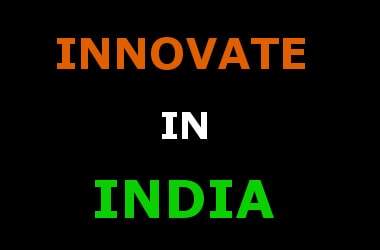 The Cabinet Committee on Economic Affairs (CCEA) has approved a collaborative mission between industry and academia called ‘Innovate in India empowering biotech entrepreneurs and accelerating inclusive innovation' that is aimed at accelerating research for early development of bio-pharmaceuticals. The Cabinet Committee on Economic Affairs (CCEA) has approved a collaborative mission between industry and academia called ‘Innovate in India empowering biotech entrepreneurs and accelerating inclusive innovation' that is aimed at accelerating research for early development of bio-pharmaceuticals.
The mission would attract an investment of INR 1,500 crore from the central government over a period of five years.
Half of the funding would be funded through a loan from World Bank.
The mission will be implemented by Biotechnology Industry Research Assistance Council (BIRAC), a public sector undertaking working under the Department of Biotechnology (DBT).
The mission will focus on key areas that would supplement country’s technological and product development capabilities in the biopharmaceutical sector to enable the sector to become globally competitive over the next 10-15 years.
The significance of the mission lies in the fact that National Biotechnology Development Strategy 2015-2020 announced by the Department of Biotechnology (DBT) lays emphasis on making the country achieve USD 100 billion biotech industry by 2025.
The mission will concentrate on development of specific products such as vaccines, biotherapeutics, medical devices and diagnostics etc.
Besides, the mission will also work on establishment of shared infrastructure and facilities.
The mission will help in building and strengthening domain specific knowledge and management skills at the same time creating and enhancing technology transfer capabilities in public and private sector.
|
▼ India gets M777 artillery gun 30 years post Bofors [05-19-17]
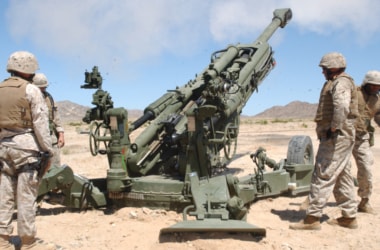 Nearly after 30 years after the induction of Bofors howitzers, Indian Army will get its first artillery guns called M777 from BAE Systems. Nearly after 30 years after the induction of Bofors howitzers, Indian Army will get its first artillery guns called M777 from BAE Systems.
Swedish Bofors guns were inducted in late 1980s after which Army has not inducted any modern artillery guns.
The two M777s has arrived in New Delhi and will be tested at the Pokhran field firing range in Rajasthan.
The two M777 guns will be used for compilation of firing tables. Indian Army has plans to equip 169 regiments with 3,503 guns by 2020. Salient
The 155 mm/39-caliber howitzers will increase the army’s capabilities in high altitude and will be deployed in the northern and eastern sectors.
The modular design of the guns would come handy in towing the guns along the narrow and treacherous mountain roads that is found in India’s borders with both Pakistan and China.
The guns can also be airlifted by using heavy-lift helicopters like the Chinook. India has signed an agreement to acquire Chinook from the US.
The C130J Super Hercules, which are used for strategic airlift by India is also capable of airlifting M777 guns.
The M777 guns are already in service in the countries like the US, Canada and Australia. These guns were deployed by these armies in Afghanistan and Iraq. The first 25 guns will be inducted directly.
The remaining 120 guns will be be assembled in India by BAE Systems in collaboration with Mahindra Defence.
|
▼ Ministry of Shipping signs MoU for skill development in coastal areas [05-19-17]
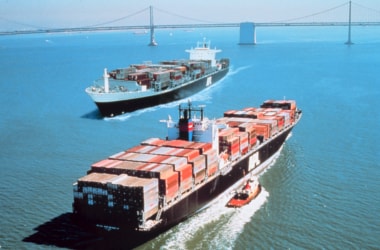 For skills development of youth in coastal areas, the Ministry of Shipping signed an MoU with the Ministry of Rural Development in New Delhi today. For skills development of youth in coastal areas, the Ministry of Shipping signed an MoU with the Ministry of Rural Development in New Delhi today.
The MoU is for convergence of the Ministry’ prestigious project Sagaramala and Ministry of Rural Development’s flagship programme Deen Dayal Upadhyay Grameen Kaushalya Yojana (DDU GKY) .
The Minister of Shipping and Road Transport & Highways, Shri Nitin Gadkari and the Minister for Rural Development, Panchayati Raj.
DDU-GKY is expected to bring in its skilling expertise to provide skilling for the coastal communities, thereby preparing them to take advantage of the job opportunities that are expected to come up in the maritime sector following port led development under Sagarmala.
This MoU will meet the exact skill needs of industries in the port and maritime sector and provide the coastal communities right skills for better opportunities emanating from the large scale impact of Sagarmala projects.
With skill development there will be close involvement of the coastal communities in Sagarmala and will make them contributors in the economic development and will ensure inclusive growth of the coastal districts of the country.
The centre is planning to facilitate fisherman with mechanized trawlers that will allow them to fish till 30-40 Nautical Miles in international ocean.
This will generate employment opportunities for youth in coastal areas, as fishing is a big industry, which involves processing, packaging and export of fish and other sea produce.
There is a need to develop tourism around lighthouses in coastal areas, as this will provide employment to rural youth in these areas.
DDUGKU is the flagship programme of the ministry and after this MoU agreement, rural youth and women of coastal areas will be able to develop skills for Maritime, Shipping and Port Management.
Under skill development pilot project, around 7,000 persons have been already been trained and out of this 600 people have been already got employment.
The Coastal Communities are key stakeholders in the Sagarmala Programme and their skill development and livelihood is an important objective of the program.
A budget of INR 100 Cr. has been allocated under Sagarmala for coastal community development activities.
Before execution, understanding the exact requirement is a key step and therefore, an on-ground survey for accurate understanding of skill needs of 21 coastal districts has been done so that the training programs can be aligned to the exact requirements.
Along with the Skill gap studies, District Action Plans have been made in consultation with the State Governments and districts concerned and training will commence from May, 2017.
Specific training needs have been identified for more than 60000 trainees in the next phase through more than 100+ skill projects.
The primary goal of the Skills and Livelihoods in Sagarmala is to meet the exact skill needs of industries in the port and maritime sector and provide the coastal communities right skills for better opportunities emanating from the large scale impact of Sagarmala projects.
It is expected that the close involvement of the coastal communities in Sagarmala will make them contributors in the economic development and will ensure inclusive growth of the coastal districts of the country.
DDU-GKY: Know More
- DDU-GKY is currently being implemented in 28 states and has over 654 training centres in 522 projects.
- It is in partnership with over 261 training partners conducting training across 39 sectors, and over 329 job-roles.
- So far a total of 4.54 lakh candidates have been skilled and 2.31 lakh candidates provided jobs.
|
▼ DD Jharkhand on the anvil [05-19-17]
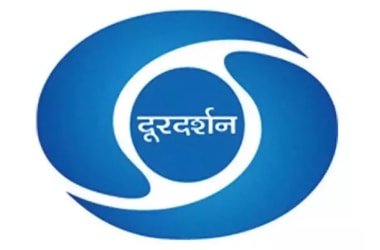 Minister for Information & Broadcasting Shri M.Venkaiah Naidu has announced a separate 24x7 DD channel for the state of Jharkhand. Minister for Information & Broadcasting Shri M.Venkaiah Naidu has announced a separate 24x7 DD channel for the state of Jharkhand.
The Government was putting up a vision document for a 24x7 DD Jharkhand channel for the people of the state and the proposal was included in the 3 years Action Plan of DD.
However till the launch of 24x7 channel, DD Ranchi programmes would be telecast on DD Bihar. Jharkhand related programmes would be provided a special window in already available 24x7 satellite channel- DD Bihar.
Government of Jharkhand has been requested to provide a dedicated power supply through separate feeders to All India Radio & Doordarshan Stations in the state. Action was being taken to cover all shadow areas of Koderma region by December 2018, to ensure 100% coverage of all geographic regions in the state by DD & AIR.
State Government was urged to make use of the platform of Community Radio to ensure last mile reach. Educational Institutions & NGOs should be motivated to set up community radio stations.
Community radio was an empowering tool which caters to the information needs of the people in local language/dialect. It broadcast programmes on various local issues relevant to the community.
Giving a boost to radio outreach, Ministry of I&B has increased the subsidy amount to 75% for stakeholders for setting up of CRS in various states.
Under the FM Phase III, 16 more Private FM channels have been proposed for the state of Jharkhand.
This state government received the Special Mention Award in the Most Film Friendly State Award category at the 64th National Film Awards.
|
▼ PFRDA-CRISIL report says India's elderly population to rise [05-17-17]
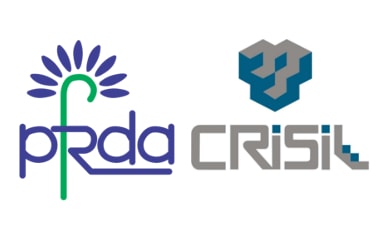 As per the PFRDA-CRISIL report titled, Financial security for India’s elderly - The imperatives, India will begin ageing gradually and transform from ‘young’ to a ‘greying’ with every 5th Indian to be in 60s in contrast to every 12th person at present. As per the PFRDA-CRISIL report titled, Financial security for India’s elderly - The imperatives, India will begin ageing gradually and transform from ‘young’ to a ‘greying’ with every 5th Indian to be in 60s in contrast to every 12th person at present.
By 2050, persons above the age of 60 would increase from the present 8.9% of the population to 19.4 %.
Also, by 2050, the population of people above 80 is likely to increase from 0.9% to 2.8%.
As of 2015, almost 90% of the population was below the age of 60 years and the proportion of working age population stood at 44% .
The report has stated that the continuously declining inter-generational support within families necessitates the development of well-developed, self- sustaining pension system in the country.
The report calls for including personal finance and retirement planning as a part of formal education curriculum as they promote the overall objective of financial literacy.
The promotion of pension system is vital as it helps in achieving twin objectives of providing income security to a vast number of ageing population.
It also assists in garnering long-term funds for critical, growth-driving sectors of the economy as also the capital market.
The report has called for sufficient incentivisation of intermediaries to increase penetration of pension system in the country.
In India, which is an under-penetrated financial market has most of the investors preferring to invest in fixed deposits (FDs), which account for more than 44% of the financial savings as opposed to the provident and pension funds which accounts to just 14% of the savings that are primarily fed by the organised section of the society.
The report has observed that in India, increasing the penetration of pension products via voluntary pension schemes is the biggest hurdle in developing the pension system.
|
▼ Mumbai airport world's busiest! [05-17-17]
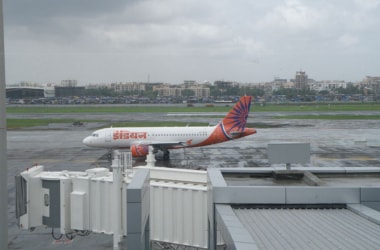 The Mumbai airport, Chhatrapati Shivaji International, has become the world’s busiest single-runway airport with 837 flights a day or one flight in 65 seconds on an average in the 2016-17 fiscal year. The Mumbai airport, Chhatrapati Shivaji International, has become the world’s busiest single-runway airport with 837 flights a day or one flight in 65 seconds on an average in the 2016-17 fiscal year.
The airport has even overtaken London’s Gatwick airport that had 757 flights a day.
The city also tops in terms of the number of passengers with almost 45.2 million people flying in and out in fiscal 2017 as against 44 million at Gatwick airport.
No other large city in the world is served by one airport that too with a single-runway.
All the leading cities in the world including New York, London, Dubai, and Singapore have more than one airport with multiple runways. The New Delhi airport also has in use three parallel runways at any given time.
In comparison, Mumbai works with just a single runway for both passenger and cargo aircraft and when it is shut for repairs, it uses the secondary runway.
The airport operates to about 95 domestic and international destinations.
The air traffic controller has to manage two arrivals every 130 seconds and one departure in between these two arrivals so, there is one take-off or touch-down every 65 seconds from the main runway.
The airport also witnesses days when the total number of flight operations cross 900.
The city has proposed for a second airport in Navi Mumbai, which is yet to come up.
The Gatwick airport, which is the second-busiest airport by total passenger traffic in the United Kingdom after London Heathrow, had held the position of being the busiest Mumbai airport with single - runway operations until March 2017 when it was overtaken by the Mumbai’s Chhatrapati Shivaji International Airport.
|
▼ TN to get multi-modal logistics park [05-16-17]
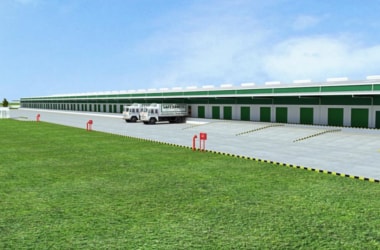 The National Highways Authority of India signed an MoU with the Tamil Nadu Industrial Development Corporation Limited (TIDCO) in New Delhi, for the development of a Multimodal Logistics Park in the Ponneri Industrial Node area near Kamarajar Port in Tamil Nadu. The National Highways Authority of India signed an MoU with the Tamil Nadu Industrial Development Corporation Limited (TIDCO) in New Delhi, for the development of a Multimodal Logistics Park in the Ponneri Industrial Node area near Kamarajar Port in Tamil Nadu.
This is an important agreement for the development of an integrated, multi-modal transport infrastructure in the country.
The Ministry of Road Transport and Highways is planning to develop Mutimodal Logistics Parks in under its Logistics Efficiency Enhancement Programme (LEEP) in 15 locations all over India at a cost of INR 33,000 crore, including INR 1295 crores investment for the Chennai Region.
The proposed logistics parks will bring down the overall freight costs, reduce vehicular pollution and congestion and will enable reduction of warehousing costs.
All this is expected to result in lower logistics costs.
|
▼ BSF to use invisible laser wall Kavach for border protection [05-15-17]
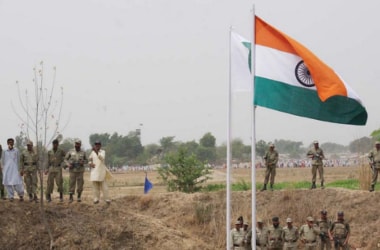 The Border Security Force will make use of the Invisible Laser Wall Kavach that is capable of detecting intrusions and relaying information to the nearest post for action to safeguard the 198 km India-Pakistan international border in Jammu and Kashmir. The Border Security Force will make use of the Invisible Laser Wall Kavach that is capable of detecting intrusions and relaying information to the nearest post for action to safeguard the 198 km India-Pakistan international border in Jammu and Kashmir.
The technology developed by the Delhi-based defence IoT firm, CRON Systems is expected to bolster BSF’s defences amid strained ties and increase in the number of infiltration bids and ceasefire violations.
The new technology called Kavach (KVx) series laser walls has been built indigenously and are a notch higher than the existing laser walls.
BSF is presently pilot testing the Kavach walls along the Samba sector border in Jammu and Kashmir.
Kavach walls have intrusion detection system based on infrared array and hence are invisible. They will also be effective in transparent water and glass.
Kavach walls are all-terrain weather-proof system that uses complex, encrypted technologies to monitor and immediately alert the nearest outpost about intrusion attempts.
It is capable of monitoring large swathes of any territory from a single interface.
The devices will use CRONet, an encrypted network, to communicate with each other.
Five such KVx-series walls will be capable of securing a kilometre-long stretch.
Indo-Pak Border: Know More
- India and Pakistan share 3000km border of which 198 km international border and 740 km Line of Control (LoC) falls in the state of Jammu and Kashmir.
- Infiltration of Pakistani terrorists along the border area which has 13 rivers and rivulets is a major issue for the BSF.
- BSF has been making use of various technologies like electric fencing, and other technologies such as laser to detect and prevent intrusions.
- Adoption of Kavach walls are the latest in the series of upgradations made by the force.
About the Technology- Kavach walls have intrusion detection system based on infrared array and hence are invisible. They will also be effective in transparent water and glass.
- Kavach walls are all-terrain weather-proof system that uses complex, encrypted technologies to monitor and immediately alert the nearest outpost about intrusion attempts. It is capable of monitoring large swathes of any territory from a single interface.
- The devices will use CRONet, an encrypted network, to communicate with each other. Five such KVx-series walls will be capable of securing a kilometre-long stretch.
|
▼ Telangana first state to create logo for hearing impaired drivers [05-15-17]
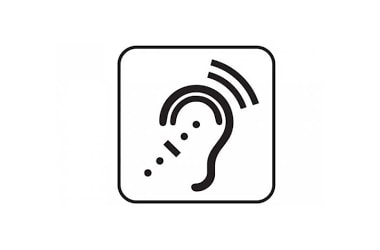 Telangana has introduced a logo for identifying vehicles driven by persons with hearing impairment and has become the first state in the country to do so. Telangana has introduced a logo for identifying vehicles driven by persons with hearing impairment and has become the first state in the country to do so.
State’s transport department has finalised the logo designed by Hyderabad-based graphic designer Manikanta Annapragada, who incidentally is the first person to obtain a driving license in the ‘hearing impaired’ category.
The logo was chosen from eight designs submitted by Manikanta himself.
According to the DC report, a hearing impaired mark is part of the logo which has the following text, “Driver is deaf - Please watch out”.
For two-wheelers, the symbols should be four inches high and three inches wide on the rear side, and three inches tall and two inches wide on the front.
The logo should be six inches tall and five inches wide at the rear side and four inches tall and three inches wide in the front for four-wheelers.
Close to 10 persons had applied for learner’s license in the hearing disability category.
Manikanta had obtained his learner’s license on May 5 from the Khairatabad Regional Transport Authority and was granted a permanent license on May 9 from Kondapur RTA.
The Union Transport Ministry in November 2016 had directed all state governments to grant driving licenses to persons with hearing impairment if the driver passes regular tests, noting that driving was a visual skill.
|
▼ Indian Exclusion Report 2016 findings [05-15-17]
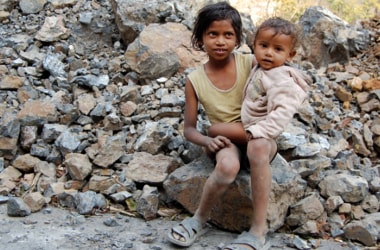 According to the 2016 Indian Exclusion Report (IXR) released by the Centre for Equity Studies (CES), in terms of exclusion from access to public goods, Dalits, Adivasis and Muslims continue to remain the worst-hit communities. According to the 2016 Indian Exclusion Report (IXR) released by the Centre for Equity Studies (CES), in terms of exclusion from access to public goods, Dalits, Adivasis and Muslims continue to remain the worst-hit communities.
The report has found out that the same historically disadvantaged groups such as Dalits, Adivasis, Muslims, and persons with disabilities and age-related vulnerabilities continue to remain as the most severely and consistently excluded groups of the society.
The 2016 IXR Report determines exclusion by taking into account four public goods, namely, pensions for the elderly, digital access, agricultural land, and legal justice for under-trials.
With the respect to the criteria of agricultural land as a public good, the report has found that the landowners to be invariably belonging to the upper castes, cultivators to be belonging to the middle castes.
Dalits and Adivasis remain largely as the agricultural workers and landlessness was highest among Dalits (57.3%).
Also, 52.6% of Muslims and 56.8% of women-headed households were landless.
In addition, Adivasis constituted around 40% of all those displaced by the developmental activities.
The report has highlighted that the Land reform efforts have not benefited Dalits, women or Muslims significantly.
The land holdings of Dalits, Muslims and women were found to be meagre in size.
Also, it has noted that the Land allotments to SC/ST households were not implemented efficiently. Internet reach
The report has observed that even though India has been ranked among the top five nations in terms of the number of internet users, almost 1.063 billion Indians were found to be offline.
It has cited poverty and geographic location to be the two major barriers to digital access.
The report has also cited the reluctance on the part of government to be a signatory to a non-binding UN Human Rights Council resolution to protect human rights on the Internet.
UNHRC: Know More
- Abbreviation : UNHRC
- Formation: 2006
- Type : United Nations System inter-governmental body
- Head: Joaquín Alexander Maza Martelli, Council President
- Parent organization: United Nations General Assembly
- Website: www.ohchr.org
|
▼ J&K gets first cricket academy [05-12-17]
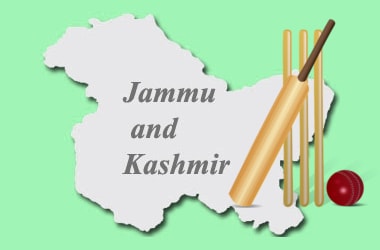 The state of Jammu and Kashmir has taken a decisive step towards grooming the young talents in the state as the “State Cricket Academy” began its operation today at Srinagar’s Bakshi stadium. The state of Jammu and Kashmir has taken a decisive step towards grooming the young talents in the state as the “State Cricket Academy” began its operation today at Srinagar’s Bakshi stadium.
The first coaching camp being held at the stadium will be for children below the age of 16.
Parveen Rasool is the only player from the state of Jammu and Kashmir to have played for the Indian national team.
The off-spinner, who has appeared in one ODI and one T20I for India has also featured for three different teams in the IPL where he last played for Royal Challengers Bangalore in last year’s edition.
SCA reiterated that its team will focus on overall development of the players and not produce only “one- trick ponies”.
The facility will look to nurture cricketers at the grassroots level and be a nursery for cricketers, who will perform on a much bigger stage in the days to come.
The first coaching camp for the U-16 cricketers in being held at a makeshift arrangement with the Sports Council still working on the facilities at the academy.
However, as per the reports from the Sports Council, the construction work for the same will be done at a rapid pace.
The academy will have all the modern facilities with includes turf as well as cemented wickets in addition to all the other basic necessities.
|
▼ Justice Karnan - First Indian judge to be imprisoned [05-11-17]
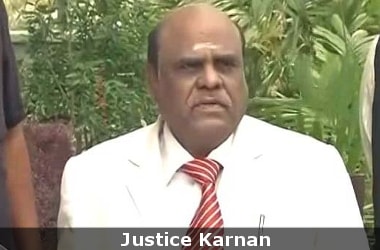 A seven-judge Constitution bench of the Supreme Court (SC), headed by Chief Justice J S Khehar, on 9 May 2017 sentenced Justice C S Karnan, the Calcutta High Court judge, to six months of imprisonment. A seven-judge Constitution bench of the Supreme Court (SC), headed by Chief Justice J S Khehar, on 9 May 2017 sentenced Justice C S Karnan, the Calcutta High Court judge, to six months of imprisonment.
Justice Karnan has been sentenced for imprisonment for repeated incidents of contempt of court.
This marks the first time that the Supreme Court has sent a high court judge to jail on charges of contempt.
Additionally, the bench, comprising Justices Dipak Misra, J Chelameswar, Ranjan Gogoi, M B Lokur, P C Ghose and Kurian Joseph, prohibited media, both print and electronic, from publishing any further orders if any passed by Justice Karnan.
The Supreme Court bench, headed by Chief Justice of India J S Khehar, in February 2017 issued a contempt notice to Justice C S Karnan.
Justice Karnan was accused of contempt after he named 20 “corrupt judges” of India earlier in 2017 and sought an investigation alleging corruption in the judiciary.
He also wrote to Prime Minister Narendra Modi urging an inquiry.
On 1 March 2017, the SC ordered the Calcutta government hospital to constitute a medical board to examine the medical condition of Justice Karnan and submit a report to the court.
However, Justice Karnan refused to undergo medical tests in compliance with courts’ orders.
He was then sentenced by the eight judges of the Supreme Court to five years of “rigorous imprisonment” and imposed a fine of INR 100000 each under the Scheduled Castes and the Scheduled Tribes (Prevention of Atrocities) Act of 1989 and the amended Act of 2015.
|
▼ Government of Jharkhand, Oracle sign MoU [05-11-17]
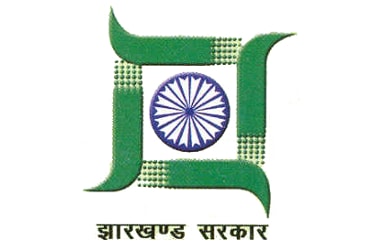 The Government of Jharkhand and Oracle on 8th May signed a Memorandum of Understanding (MoU) intended to improve citizen services. The Government of Jharkhand and Oracle on 8th May signed a Memorandum of Understanding (MoU) intended to improve citizen services.
The agreement also works to make Jharkhand an attractive destination for start-ups.
Oracle will offer its support to the state through its vast portfolio of technology solutions, including Oracle Cloud - which are already powering a large number of governments globally.
These solutions cater to the growing requirements and expectations of citizens, businesses and government departments for smarter, transparent and efficient governance within the state of Jharkhand.
As part of the MoU, the Government of Jharkhand and Oracle will jointly explore and identify areas in which Oracle’s latest cloud-based technologies can be used to deliver improved citizen services and to address the state’s citizen and business requirements.
The state administration intends to use Oracle’s cloud-based solutions to build a platform to encourage innovation and entrepreneurship among its youth, helping establish Jharkhand as a preferred start-up destination in India.
Jharkhand also received investment support from the Centre for an internal venture capital fund to support start-ups in the State.
Under the MoU, Oracle and the Government of Jharkhand will collaborate to create proof of concepts and help new startups using Oracle Cloud-based platforms to operationalise citizen services and start-up centres aimed at increasing employment and alleviate poverty.
Oracle: Know More
- Headquarters: Redwood City, California, United States
- Subsidiaries: NetSuite, Dyn, Art Technology Group, Taleo, Endeca
- Founders: Larry Ellison, Ed Oates, Bob Miner
|
▼ DIPP, WIPO ink pact [05-10-17]
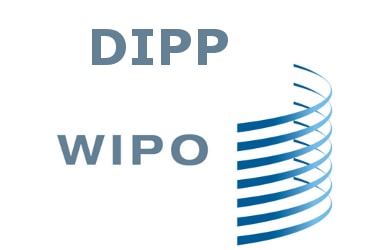 The Department of Industrial Policy and Promotion (DIPP) and World Intellectual Property Organisation (WIPO) have inked an agreement to set up Technology and Innovation Support Centres (TISC). The Department of Industrial Policy and Promotion (DIPP) and World Intellectual Property Organisation (WIPO) have inked an agreement to set up Technology and Innovation Support Centres (TISC).
Over 500 TISCs operate worldwide and establishing TISC in India will give the host institutions access to the global network, it said.
WIPO’s Technology and Innovation Support Centres (TISC) program provides innovators in developing countries with access to locally based, high quality technology information and related services, helping them to exploit their innovative potential and to create, protect, and manage their intellectual property (IP) rights.
Services offered by TISCs may include
- Access to online patent and non-patent (scientific and technical) resources and IP-related publications;
- Assistance in searching and retrieving technology information;
- Training in database search;
- On-demand searches (novelty, state-of-the-art and infringement);
- Monitoring technology and competitors;
- Basic information on industrial property laws, management and strategy, and technology commercialization and marketing.
CIPAM: Know More- The Cell for IPR Promotion and Management (CIPAM) is designated as the National Focal point for the TISC national network.
- As the national focal point, CIPAM shall identify potential host institutions, assess their capacities and support them in joining the TISC project.
- CIPAM will also act as the main intermediary between WIPO and TISC host institutions and coordinate all the activities of the national TISC network.
- In upcoming years CIPAM is planning to establish TISC’s in Universities, State Science Councils, R&D institutions etc.
- TISC will give an impetus to Knowledge sharing, sharing of best practices among the TISC’s, capacity building, generation and commercialization of IPs
|
▼ Baahubali sequel India’s highest grossing movie [05-10-17]
 SS Rajamouli’s Baahubali 2: The Conclusion became the first Indian film to cross the INR 1000 crore mark with its worldwide collections. SS Rajamouli’s Baahubali 2: The Conclusion became the first Indian film to cross the INR 1000 crore mark with its worldwide collections.
Reports suggest that trade analysts have reported that the film has made over INR 800 crore in India and more than INR 200 crore in the international markets.
The two films in the series namely Baahubali: The Beginning and Baahubali 2: The Conclusion had a budget of around INR 450 crore.
The film was released in Hindi, Tamil, Telugu and Malayalam.
The film has not only broke the records of a collection of films like Aamir Khan’s Dangal and PK but has also outperformed the lifetime collection of its predecessor in the series, Baahubali: The Beginning.
The film co-written and directed by SS Rajamouli and produced by Tollywood studio Arka Media Works is the continuation of Baahubali: The Beginning.
The film was released worldwide on 28 April 2017.
It is also the first Telugu film to be released in 4K High Definition format.
Earlier, it became the first Indian film to get a worldwide gross of more than INR 500 crore in all languages in just three days.
Baahubali 2 became the highest grossing Indian film ever with the worldwide gross of approx INR 900 crore in all languages in just seven days, surpassing PK worldwide gross of INR 792 crores.
On the 9th day, Baahubali 2 became the first Indian film ever to collect INR 1000 crore.
|
▼ Anti Naxal operations command HQ of CRPF shifted to Raipur [05-9-17]
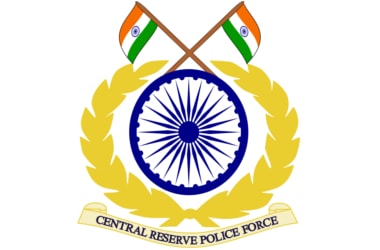 The strategic anti-Naxal operations command headquarters of the Central Reserve Police Force (CRPF) has been shifted back from Kolkata to Raipur. The strategic anti-Naxal operations command headquarters of the Central Reserve Police Force (CRPF) has been shifted back from Kolkata to Raipur.
In 2010, the central zone command headquarters was shifted from Raipur to Kolkata owing to logistics and connectivity issues.
The recent decision comes at the backdrop of ambush in Sukma district that killed 37 jawans of the paramilitary force.
The central zone command headquarters was raised on August 7, 2009, to carry out the deployment of troops to the States affected by Left Wing Extremism such as West Bengal, Jharkhand, Bihar, Chhattisgarh, Odisha, Madhya Pradesh and Uttar Pradesh.
CRPF: Know More
- CRPF is the largest central armed police force or paramilitary force in India.
- It operates under the aegis of Ministry of Home Affairs (MHA).
- It was established in 1939, under Crown Representative’s Police but after independence, it was made statutory after enactment of the CRPF Act, 1949.
- Its primary role is to assist States/Union Territories in police operations to maintain law and order and contain the insurgency.
- Apart from anti-Naxal operations, CRPF personnel also carries out several operations in situations of crisis like terrorist attacks, counter-terrorism operations, rescuing citizens during terrorist attacks among others.
|
▼ Times Rich List 2017: 3 Indian born among top 5 richest in UK [05-9-17]
 As per the Times Rich List 2017, three India-born citizens are among top 5 richest people in Britain. The 29th edition of the Sunday Times Rich List’ released the names of UK’s 1000 wealthiest people including 40 Indian-born citizens. As per the Times Rich List 2017, three India-born citizens are among top 5 richest people in Britain. The 29th edition of the Sunday Times Rich List’ released the names of UK’s 1000 wealthiest people including 40 Indian-born citizens.
Hinduja Brothers Srichand and Gopichand have topped the list to become the top of 134 billionaires in the country. The Hinduja brothers has estimated assets worth 16.2 billion pounds.
Their investments in various industries include oil and gas, automotive, IT, energy, media, banking, property and healthcare sectors.
The Mumbai-born David and Simon Reuben has been placed at the third position in this year’s list with a net estimate of approximately 14 billion pounds.
The Reuben brothers made their wealth with lucrative property deals. The Reuben brothers were holding the first place in the previous editions list.
The famous steel tycoon Lakshmi Mittal has jumped up seven spots in this edition’s list to reach the fourth spot this year. His net worth is estimated to be approximately 13.23 billion pounds.
This year’s list features a total of 40 Indian-origin people in the rankings. The other prominent Indians in the list include Gujarati brothers Mohsin and Zuber Issa of Euro Garages at 133rd position and Lord Swraj Paul, an NRI with an estimated fortune of 600 million pounds at 194th position.
Interestingly, in this year’s edition, there is not even a single Briton among the top 5 wealthiest in Britain.
Overall, the billionaires in the United Kingdom are far richer than before as it is held widely that the billionaires reaped benefits from Brexit boom.
The assets of UK’s top 500 people and families in this edition are much more than the last year’s wealthiest 1,000.
However, the list compiler has stated that the revival in the stock market to be the reason behind the growth of fortunes.
The second place in the list was allotted to the Ukrainian businessman Len Blavatnik. Duke of Westminster, Hugh Grosevenor, has been ranked 9th with assets worth 9.52 billion pounds.
Sunday Times Rich List
- The Sunday Times Rich List is a list of the 1,000 wealthiest people updated annually in April.
- It is published by British national Sunday newspaper since 1989.
- Apart from the British citizens, the List also includes individuals and families born overseas who predominantly work or live in Britain.
|
▼ India's first integrated bio refinery in Rahu, Pune [05-9-17]
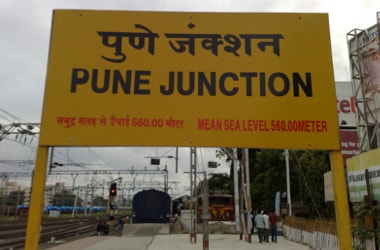 Union Minister for Road Transport, Highways and Shipping Nitin Gadkari has inaugurated India’s First Integrated Bio-refinery for Renewable Fuels & Chemicals for producing ethanol from varied biomass. Union Minister for Road Transport, Highways and Shipping Nitin Gadkari has inaugurated India’s First Integrated Bio-refinery for Renewable Fuels & Chemicals for producing ethanol from varied biomass.
The plant is based at Rahu in Pune district of Maharashtra. The demonstration plant has been constructed by Praj industries.
The inaugurated Bio-refinery plant is capable of producing 1 million litres of ethanol per annum by processing a variety of biomass like rice and wheat straw, cane trash, corn cobs, cotton stalk, bagasse, & stover with superior product yields.
In the year 2015, the GoI has asked Oil Marketing Companies (OMCs) to target 10 % blending of ethanol in as many States as possible.
The fuel doping programme that required blending of 5% ethanol had started in November 2012. It was notified under the Motor Spirits Act on January 2, 2013.
The Government has also permitted the OMCs to procure ethanol produced from other non-food feedstocks, like cellulosic and lignocellulosic materials including petrochemical route.
Biofuels: Know More
- Ethanol blending is the practice of blending petrol with ethanol.
- Internationally many countries including India, have resorted to ethanol blending to reduce vehicle exhaust emissions
- The inauguration of the refinery paves the way for increasing 20% ethanol blending program and can reduce the import burden of crude petroleum.
- Biofuels are fuels which are derived from biomass.
- The term covers solid biomass, liquid fuels and various biogases and also denotes Biodiesel, Bio-alcohol and bio-gasoline.
- The most well known Biofuel crops include Sunflower seeds, Wheat, Sugarbeet, Cassava, Algae, Coconut, Jojoba, Castor Beans, Corn, Rapeseed/Canola, Sugarcane, Palm Oil, Jatropha, Soyabean, Cottonseed.
|
▼ BBIN MVA at crossroads [05-9-17]
India is back at the drawing board on BBIN (Bangladesh-Bhutan-India-Nepal) Motor Vehicles Agreement (MVA), an ambitious sub-regional transport project, even as Bhutan has shelved it for the time being.
The BBIN, which is promoted by India and aimed at creating seamless connectivity between the four countries for enhanced sub-regional trade and movement of people, suffered a blow on April 29, with Bhutan announcing that it will not be able to ratify the plan before it addresses some of concerns raised domestically over the project.
Just that India and the other three countries will have to redraw plan.
They can join it once they are ready, but as a new member.
With the final approval from Bhutan, the plan would have come into force.
The lower house of Bhutanese Parliament had also rejected it in November last year but there were hopes that the Upper House would approve it.
The joint working group on BBIN, which was due to meet this month, will now meet next month to redesign the routes. This is because, as per the present plan, some corridors are starting from Paro and Phuentsholing in Bhutan connecting Dhaka and then Kolkata.
Thereafter, protocols have to be amended by India, Bangladesh and Nepal separately, after which, each of these countries will have to pass the edited protocols through their respective Parliaments because this is an international agreement.
The reason behind Bhutan’s hesitance to sign the pact now is because of environmental concerns raised by a section of the country’s citizens.
Ironically, the deal was signed in Thimpu on June 15, 2015, as part of the commitments made in the 18th SAARC Summit held in Kathmandu, Nepal.
The larger MVA project is aimed at connecting all those countries that share land borders.
The BBIN MVA is also touted to be the cornerstone for Prime Minister Narendra Modi’s ‘Look East’ strategy in his key foreign policy initiatives.
India’s share in sub-regional trade is over 90 per cent.
In 2015, India’s volume of total trade with BBIN countries was about $10.82 billion, of which exports accounted for $9.35 billion and the remaining was India’s import from BBIN, according to the IMF.
|
▼ Odisha launches boat ambulance service [05-9-17]
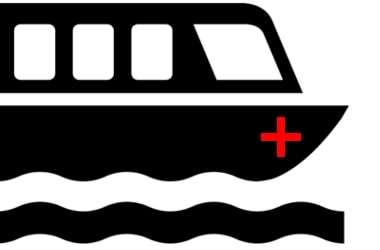 To augment the existing healthcare delivery system, Odisha government has decided to allocate six boat ambulances in four districts where people are facing problems in availing 108 ambulance service. To augment the existing healthcare delivery system, Odisha government has decided to allocate six boat ambulances in four districts where people are facing problems in availing 108 ambulance service.
The boat ambulance service will be made available in Koraput, Kendrapara, Kalahandi and Malkangiri districts through state funds.
A memorandum of understanding (MoU) was signed on Saturday between the State government and the Ziquitza Health Care as part of the major initiative to boost health care services.
The government will also shortly add 92 Basic Life Support (BLS) ambulances to its fleet of 420 ambulances that are now in operation in different parts of the state.
INR 21, 21 crore will be spent towards extending emergency ambulance services in the entire state.
Besides, the state government signed another MoU with the Public Health Foundation of India (PHFI) for imparting post graduation diploma course to the serving doctors in different district headquarters hospital across the State.
Odisha: Know More
- Founded: 1 April 1936
- Capital: Bhubaneswar
- Population: 43.73 million (2014)
|
▼ Vijayawada airport gets international status [05-5-17]
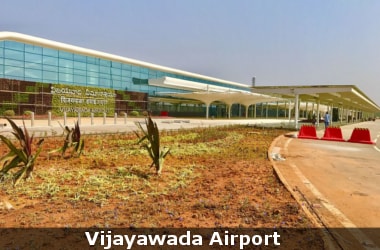 The Union Cabinet today gave its nod to international status for Vijayawada airport in Andhra Pradesh. The Union Cabinet today gave its nod to international status for Vijayawada airport in Andhra Pradesh.
This is as per provisions of Andhra Pradesh Reorganisation Act, 2014, Union minister Arun Jaitley announced.
The act bifurcated the state into Telangana and residual Andhra Pradesh.
As a result, the capital Hyderabad as well as the state’s lone international airport situated in the city were transferred to the new state of Telangana.
The decision is in keeping with passenger traffic growth and demands from airlines and Andhra Pradesh government.
The government hopes that the international tag for the airport at Gannavaram near Vijayawada will help improve connectivity to Andhra Pradesh and attract more domestic and international tourists.
Airports Authority of India has undertaken upgrade of requisite infrastructure and facilities for international operations.
Chief Minister N Chandrababu Naidu inaugurated the new transit terminal building at the airport as well.
Urban Development Minister Venkaiah Naidu welcomed the decision and said this will help generate employment for at least 1,150 people.
The Andhra Pradesh Reorganisation Act, 2014 provides that the Centre must examine the feasibility of expanding the existing Visakhapatnam, Vijayawada and Tirupati airports to international standards and take an expeditious decision thereon.
Vijayawada Airport: Know More
- Address: Gannavaram, Andhra Pradesh 521102
- Code: VGA
- Elevation: 25 m
- Owner: Airports Authority of India
- Serves: Vijayawada
- Airport type: Public
|
▼ World's tallest railway bridge higher than Eiffel Tower! [05-5-17]
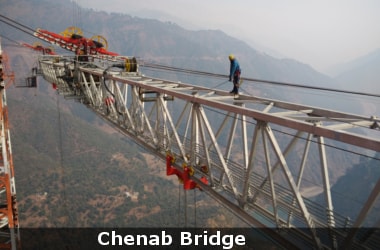 A railway bridge taller than the Eiffel Tower is being built across the Chenab river in Jammu and Kashmir and is slated to be ready by 2019. A railway bridge taller than the Eiffel Tower is being built across the Chenab river in Jammu and Kashmir and is slated to be ready by 2019.
It will be the world's highest railway bridge. The 1.3 km long "engineering marvel" will connect Bakkal in Jammu's Katra and Kauri in Srinagar.
The arch-shaped 35-metre tall structure is being constructed at a cost of 1,110 crores.
The bridge will be a crucial link that connects the Kashmir valley to the rest of the country, part of the Udhampur-Srinagar-Baramulla rail link project.
Once completed, it will break the record of the 275-metre tall Shuibai railway bridge in China.
The mammoth structure will be made of over 24,000 tonnes of steel and will rise 359 metres above the Chenab bed.
The special blast-proof steel can withstand terror attacks and can resist extremely low temperatures and high wind speeds.
To safeguard the bridge and the train passengers, an aerial ring of security, online monitoring and a warning system will be in place.
India's longest road tunnel between Chenani and Nashri in the state was also flagged off recently.
With the roads in the region being prone to snow and landslides in winter, the Jammu-Srinagar national highway remains blocked for most parts of the season, cutting the Kashmir valley off from the rest of the country.
|
▼ Indore - India's cleanest city [05-5-17]
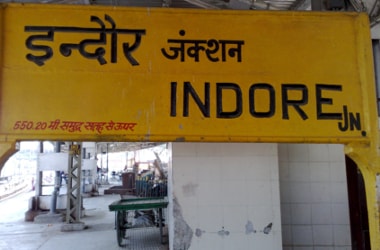 Indore has emerged as the India’s Cleanest City in the Swachh Survekshan-2017 conducted in 434 cities and towns. Indore has emerged as the India’s Cleanest City in the Swachh Survekshan-2017 conducted in 434 cities and towns.
Bhopal, Visakhapatnam, Surat, Mysuru, Tiruchirapally, New Delhi Municipal Council, Navi Mumbai, Vadodara and Chandigarh are among the Top 10 clean cities in that order.
10 towns that came at the bottom of the 434 surveyed are; Gonda (UP) ranked 434 followed by Bhusawal (Maharashtra), Bagaha (Bihar)- 433, Hardoi (UP)-432, Katihar (Bihar)-431, Bahraich (UP)-429, Muktsar (Punjab)-427, Muktsar (Punjab)-426 and Khurja (UP)-425.
Announcing the Survey Results, Shri Naidu described Madhya Pradesh, Gujarat, Jharkhand and Chattisgarh followed by Andhra Pradesh and Telangana as the Movers and Shakers for having significantly improved their rankings from that of the Survey conducted in 2014 before the launch of Swachh Bharat Mission in October, 2014.
Swachh Survekshan conducted in 2016 covered 73 cities with over million population each besides capital cities.
In Swachh Surekshan-2017, all the cities surveyed in Madhya Pradesh and Jharkhand have substantially improved their rankings over that of 2016 and 2014. Gujarat did so in respect of all cities excepting Rajkot and similar being the case in respect of Chattisgarh except Bilaspur.
In Telangana, only two cities have dropped in rankings this year while it happened in respect of four cities in Andhra Pradesh.
Of 14 States that were represented in the Top 50 clean cities, Gujarat accounting for 12, followed Madhya Pradesh-11, Andhra Pradesh-8 and one each from Chandigarh, Chattisgarh, Delhi, Jharkhand, Karnataka, Sikkim and Uttar Pradesh.
25 towns from Uttar Pradesh are ranked among the bottom 50 cities with followed by Rajasthan and Punjab with five each, two in Maharashtra and one each from Haryana, Karnataka and Lakshadweep.
Varanasi has however, improved its rank from 418 in 2014 to 32 this year to become the Fastest Big City Mover in the North Zone.
UP, Bihar, Rajasthan, Punjab and Kerala need to substantially step up efforts to improve sanitation standards in urban areas.
Faridabad in Haryana has improved its rank from 379 in 2014 to 88 this year and has been awarded for being the ‘Fastest Mover’ among cities with a population of above one million each.
37 lakh citizens provided feedback on cleanliness in 434 cities and towns accounting for about 60% of the total urban population in the country.
38 cities were awarded including the Top five clean cities at the national level, cleanest cities and fastest movers in different zones in 5-10 lakh and 2-5 lakh population categories.
Swachh Survekshan: Know More
- Swachh Survekshan-2017 aimed at capturing the outcomes on ground of the ongoing efforts to make urban areas Open Defecation Free.
- It also seeks to improve door-to-door collection, processing and disposal of Municipal Solid Waste.
- Of the total score of 2,000, 900 marks were assigned for performance in respect of ODF and solid waste management, 600 marks for Citizen Feedbak and 500 marks for Independent Observation.
- Quality Council of India that conducted the survey during January-February this year deployed 421 assessors for on the site inspection of cleanliness in 434 cities and towns and another 55 for real time monitoring of progress of survey and field inspections.
- Field inspectors used geo-tagged devices for collecting evidence in real time of their inspection at 17,500 locations.
Top 20 Cities: Swachh Survekshan Survey 2017| Ranking | City | State |
|---|
| 1. | Indore | Madhya Pradesh | | 2. | Bhopal | Madhya Pradesh | | 3. | Visakhapatnam (Vizag) | Andhra Pradesh | | 4. | Surat | Gujarat | | 5. | Mysuru (Mysore) | Karnataka | | 6. | Tiruchirappalli (Trichy) | Tamil Nadu | | 7. | New Delhi Municipal Council (NDMC) | Delhi | | 8. | Navi Mumbai | Maharashtra | | 9. | Tirupati | Andhra Pradesh | | 10. | Vadodara | Gujarat | | 11. | Chandigarh | Chandigarh | | 12. | Ujjain | Madhya Pradesh | | 13. | Pune | Maharashtra | | 14. | Amdavad (Ahmedabad) | Gujarat | | 15. | Ambikapur | Chattisgarh | | 16. | Coimbatore | Tamil Nadu | | 17. | Khargone | Madhya Pradesh | | 18. | Rajkot (M. Corp) | Gujarat | | 19. | Vijayawada | Andhra Pradesh | | 20. | Gandhinagar (NA) | Gujarat |
|
▼ Gauvansh Chikitsa Mobile Vans: Cow ambulance service launched [05-4-17]
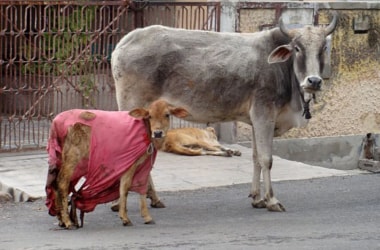 Uttar Pradesh Deputy Chief Minister Keshav Prasad Maurya has flagged off an ambulance service that would cater to the needs of the cows. Uttar Pradesh Deputy Chief Minister Keshav Prasad Maurya has flagged off an ambulance service that would cater to the needs of the cows.
Under the ‘Gauvansh Chikitsa Mobile Vans’ service, initially, 5 ambulances were flagged off to cover Lucknow, Gorakhpur, Varanasi, Mathura and Allahabad.
The ambulance will have a veterinary doctor along with an assistant to rescue ill or injured cows and transport them to ‘gau shalas’ or take them for treatment to the veterinary hospital.
In addition, a “gau seva toll-free number” has also been released to enable common people to come forward to help the cows.
The ambulance service will be run in collaboration with the MNREGA Mazdoor Kalyan Sanghathan.
Mazdoor Kalyan Sanghathan is an organization that claims to work for the welfare of the labourers and others employed in the informal sector.
The organization has a presence in 5 states. A similar initiative to save cows was initiated in Khargone district of Madhya Pradesh a few days ago.
|
▼ Dubai first city to have Microsoft font [05-3-17]
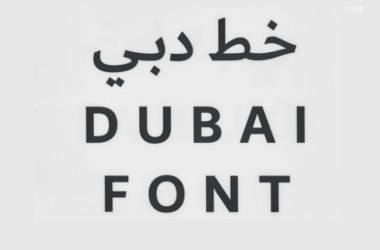 Dubai has become the first city in the world to have its own Microsoft font. Dubai has become the first city in the world to have its own Microsoft font.
The font will have typeface both in Latin and Arabic script.
It will be made available in 23 languages - Afrikaans, Arabic, Basque, Britannic, Catalan, Danish, Dutch, English, Finnish, French, Gaelic, German, Icelandic, Indonesian, Italian, Norwegian, Farsi, Portuguese, Sami, Spanish, Swahili, Swedish and Urdu.
The Microsoft font was launched by the Crown Prince of Dubai Shaikh Hamdan Bin Mohammad Bin Rashid Al Maktoum.
The font will be used by UAE’s government bodies and also by 100 million Office 365 users around the world.
UAE has launched the ‘Dubai Font’ in line with its vision of becoming a regional and global leader in innovation.
The country views the launch as a part of its continuous efforts to be ranked first in the digital world.
The country expects the new font and its unique specifications to become popular online and in smart technologies across the world.
The launch of new font is expected to boost the emirate’s competitiveness in smart technology.
Dubai: Know More
- Dubai is the largest city in UAE.
- It has the world’s tallest tower, Burj Khalifa.
- Dubai has been taking a series of initiatives to broaden its appeal by investing in technology and culture.
- Dubai will play host to the six-month Expo 2020 under the themes of sustainability and mobility.
|
▼ Communications ministry launches Tarang Sanchar [05-3-17]
 The Minister of Communications Shri Manoj Sinha launched Tarang Sanchar, a web portal for Information sharing on Mobile Towers and EMF Emission Compliances . The Minister of Communications Shri Manoj Sinha launched Tarang Sanchar, a web portal for Information sharing on Mobile Towers and EMF Emission Compliances .
The portal will allow users to get a tower or base station checked for radiation emission, for a fee of INR 4,000.
Over 25,000 studies by WHO in the last 30 years provide no proof that EMF radiation has any harmful effect on human health.
Indian norms had prescribed 10 times stricter limits for radiation emission in comparison to global standards.
There are 14.5 lakh base stations (BTSs) spread across the country of all technologies (2G, 3G, 4G etc.) and of all Telecom Service Providers (TSPs).
The portal will be a mile stone for transparency, fair play, citizen empowerment and will finally lead to a knowledge economy.
Any person can request for EMF emission measurement at a location by paying a nominal fee of INR 4000/- online.
The tests will be conducted by the local Telecom Enforcement Resource and Monitoring (TERM) filed unit of DoT and the test report will be provided to the requestor.
The portal also has ‘EMF Overview’ and ‘Learn’ Sections, which provide numerous articles, booklets and videos, to further educate the citizens about EMF and coverage of telecom services.
|
▼ Sushila Karki, Nepal's CJ, suspended [05-2-17]
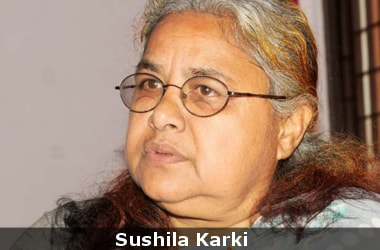 Nepal's first woman SC chief justice was suspended following an impeachment motion filed in the parliament making accusations against her of bias and interference with executive powers. Nepal's first woman SC chief justice was suspended following an impeachment motion filed in the parliament making accusations against her of bias and interference with executive powers.
Karki was suspended automatically after the motion signed by nearly half the members in the parliament was registered.
Deputy PM Bimalendra Nidhi resigned in protest because he disagreed with the motion against the CJ, which he feels will create a gap between the legislature and the judiciary. He was also the home minister.
Nidhi is from the Nepali Congress party, one of the two ruling parties whose members signed the motion.
Karki was accused of interfering with executive powers and issuing biased decisions. The motion cited a court order overturning the government’s appointment of the police chief.
The motion, filed late Sunday, needs to be debated in parliament and then receive two—thirds of the votes in the 601—seat parliament for it to be approved.
Karki was known for zero tolerance against corruption. She was appointed chief justice in April 2016 and was due to retire next month.
Sushila Karki: Know More
- Sushila Karki ( born 7 June 1952 ) in Biratnagar who became first woman Chief Justice of Supreme Court of Nepal on 13 April 2016.
- The Constitutional Council headed by Prime Minister KP Oli recommended her name for the post of Chief Justice of Supreme court of Nepal.
- She is the first woman to lead the judiciary of Nepal.
- She is known for her zero tolerance against corruption in the judiciary.
- On 30 April 2017, she was registered with impeachment motion by Maoist Centre and Nepali Congress.
|
▼ Telecom subscriber base touches 1.18 bn mark [05-2-17]
India’s telecom subscriber base, mobile and landline combined, touched the 1.18 billion mark at the end of February 2017, growing 1.17 percent over the previous month. This is as per figures of TRAI.
The market growth was propelled by the addition of 13.75 million mobile users during the month.
The demand for once- popular landline phone has been dwindling as the cheap mobile handsets, coupled with falling tariffs and freebies, have led to an explosion in cellphone connectivity.
Over the past few months, operators including newcomer Reliance Jio and incumbents like Bharti Airtel and Vodafone have been doling out attractive offers and programmes to lure customers.
The number of telephone subscribers in India increased from 1,174.80 million at the end of January 2017 to 1,188.5 million at the end of February 2017, showing a monthly growth rate of 1.17 per cent.
The urban connectivity went up to 692.15 million in February-end, from 681.15 million in January-end, a growth of over 1.6 per cent.
The pace of growth of rural connectivity was slower at 0.56 per cent. Rural telecom users increased to 496.39 million from 493.65 million during the same period.
The Indian telecom market – the second-largest in the world after China in terms of subscriber base – added 13.75 million mobile customers in February.
This pushed up the total mobile subscriber base to 1.16 billion.
The wireline connections - which have been losing sheen over the last few years – remained flat with subscriber base stagnant at about 24.35 million.
Lesser number of people sought network port outs in February compared to the previous month.
Nearly 5.6 million subscribers submitted requests for mobile number porting in February, compared to 6.24 million placing such request in January this year.
In February 2017, 5.67 million subscribers submitted their requests for mobile number portability (MNP),according to TRAI.
Alongside this, the cumulative requests increased from 261.06 million at the end of January 2017 to 266.73 million at the end of February since implementation of this facility nearly seven years ago.
MNP numbers need to be seen in the broader context of the overall subscriber base of India and not on a standalone basis.
In some markets like the US and Europe, the MNP ratio is nearly 3-5 per cent of the overall base whereas in India, the number is much smaller.
The facility of number portability allows mobile subscribers to retain their numbers when they relocate from one service area to another or wish to change their operator.
|
▼ 101 year old Mann Kaur oldest person to sky walk Sky Tower [05-2-17]
101-year-old athlete, Mann Kaur, on 27 April 2017 became the oldest person to sky walk around Auckland’s famous landmark Sky Tower.
Having set a new world record on the field, Kaur stepped out 192 metres above Auckland city to achieve the feat.
The athlete from India held her 79-year-old son Gurdev Singh’s hand as she inched along the narrow platform towering high above the city centre.
On 26 April 2017, Kaur broke the Guinness World Record for javelin with a throw of 5 m 12 in her final competition at the Trusts Stadium in Waitakere, west Auckland.
Earlier on 24 April 2017, the athlete clinched the 100 metres sprint at the World Masters Games held in Auckland, New Zealand. The World Masters Games is an international multi-sport event.
World Masters Games: Know More - It is held every 4 years.
- The event is governed by the International Masters Games Association.
- The World Masters Games is open to sports people of all abilities and most ages.
- Anyone can participate in the games so long as they are over the age of 35 though some sports will allow athletes who are younger than that.
- Participants compete for themselves as there are no country delegations.
- In 1985, Toronto had staged the first World Masters Games.
|
▼ North Korea launches ballistic missile, confronts US [05-2-17]
North Korea has test-fired a ballistic missile defying global pressure and warnings from the United States and its main ally, China.
The test was conducted from the Pukchang region present in the north of the North Korean capital, Pyongyang.
The test has failed and it is North Korea’s fourth successive unsuccessful missile test since March.
The missile launched is expected to be a medium-range weapon known as a KN-17 and appears to have disintegrated within minutes of taking off.
In February, it successfully launched a new intermediate-range ballistic missile defying global pressure that is capable of carrying a nuclear weapon.
Similarly, it also successfully tested ballistic missiles on March 6. But since then it has caused a series of failed missile tests.
The reasons behind the failed tests are largely unknown.
|
▼ India on priority watchlist list for IPR [05-2-17]
Watchdog US Trade Representative’s (USTR) office has once again placed India on the ‘priority watch’ list in this year’s Special 301 report.
This is inspite of the country rolling out National IPR Policy last year.
India has been placed in ‘priority watch’ list owing to USTR’s view that India has not made adequate changes in its intellectual property (IP) laws and regulations.
India has been placed on the ‘Priority Watch List’ for decades now and is likely to remain in the ‘Priority Watch List’ category for having inadequate IPR laws and patent protection. Bac
Similar to USTR’s Special 301 Report, India is being ranked poorly in the IPR index being done by the US Chamber of Commerce’s Global Intellectual Property Center (GIPC).
United States Trade Representative (USTR): Know More - This is an agency that is part of the executive office of the President of the US.
- USTR creates an annual Special 301 list since 1989.
- USTR places those countries that have either national laws or regulations that detrimentally affect US trade or the rights of IP holders on this list.
- USTR places these countries in three categories.
- The most egregious violators are featured as Priority Foreign Countries (PFC), serious offenders are featured on the Priority Watch List (PWL), and less serious offenders in the Watch List (WL).
- The Special 301 list has continuously placed India most often as a PWL country.
|
▼ Kazakhstan opens honorary consulate in Chennai [05-2-17]
This consulate covers TN, Kerala, and Karnataka. This consulate is headed by Suraj Shantakumar.
2017 marks the 25th anniversary of the establishment of diplomatic relations between India and Kazakhstan.
Kazakhstan has expressed confidence that the establishment of the consulate in Chennai, which is a major industrial centre would promote the potential for economic cooperation in a number of areas like IT industry, engineering, tourism, transport infrastructure, as well as agricultural production.
Among the countries that made up the former USSR, Kazakhstan has emerged as the second largest economic partner for India.
Kazakhstan is natural resources, minerals, oil and gas and chemical products.
It is currently the largest exporter of Uranium to India. The prospectus of cooperation looms large in several areas.
The bilateral trade between the two countries was around 618 million USD in 2016.
India exports pharmaceuticals, tea, tobacco, and engineering equipment to Kazakhstan and imports oil products, metals and natural minerals from here.
|
▼ Shah Rukh Khan delivers TED Talk [05-2-17]
Bollywood actor Shah Rukh Khan on 27 April 2017 became the first Indian actor to deliver TED speech in Vancouver, Canada.
He spoke out on various issues beginning from his stardom to the changes world has experienced with the introduction of the internet. He left the audience in splits with his witty one-liners.
Moreover, Shah Rukh Khan also partnered with the company to host the Hindi version of the famous talk show.
A successful actor, businessman and a philanthropist, Khan is also a noted speaker.
Shah Rukh has also delivered some motivational and inspirational speeches earlier when he was conferred with honorary doctorate from the University of Edinburg and Hyderabad’s Maulana Azad National Urdu University.
TED Talks: Know More - Founded in 1984, TED stands for Technology, Entertainment, Design.
- It is a media organisation dedicated to posting online talk shows under the slogan of ‘Ideas Worth Spreading’.
- The annual TED conference takes place in Vancouver, Canada every year where speakers are given a maximum time of 18 minutes to express their ideas in the most innovative ways they can.
- Some of the past Ted speakers include Bill Gates, Serena Williams, Pope Francis, Bill Clinton, David Cameron and others.
|
▼ India's first digitalised panchayat ward in Kerala [05-2-17]
A ward in the district became India’s first digitalised panchayat ward.
Union minister of state for social justice and empowerment Krishan Pal Gurjar inaugurated the website of the first digitalised panchayat ward number 15 of Aymanam grama panchayat.
This small panchayat ward in Kerala has become the first one to go digital in the country.
Details of 423 families and 1,262 members in the ward are now a click away.
The Aadhaar number of each member has been linked to their mobile number. Ward members can also receive mobile alerts and voice messages in cases of emergency.
Information related to the panchayat will be displayed on the website. Residents would be able to get various applications forms here.
They can also apply online.
Eligible candidates will get alerts and information about various projects of the panchayat.
The website also has blood group detail of members and a list of donors.
Information regarding Grama sabhas and drinking water supply will also be available.
The website also has provision through which residents can register complaints or share ideas.
|